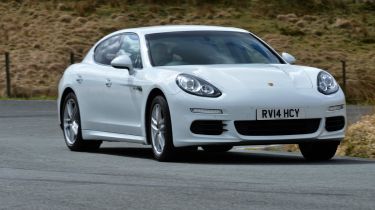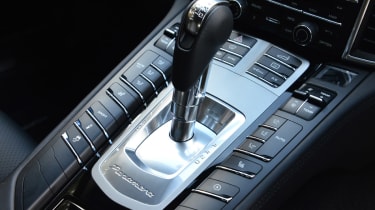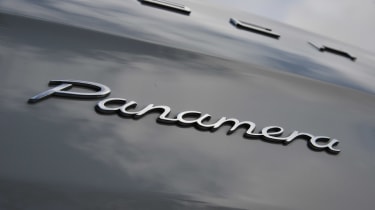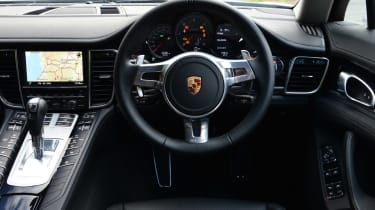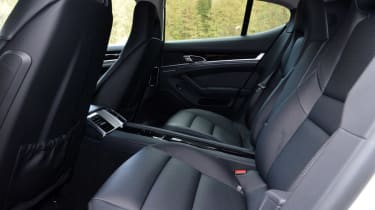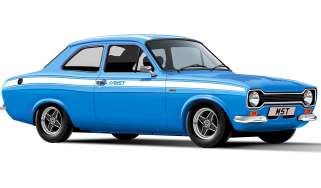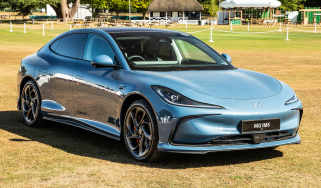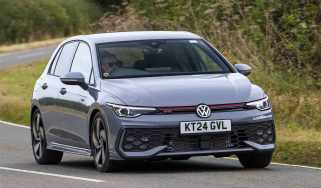Porsche Panamera (2010-2016) review
The four-door Porsche Panamera saloon offers performance and prestige from diesel, hybrid and Turbo models

Since the Porsche Panamera arrived in 2009, the luxury four-door saloon has barely changed from a design standpoint. What has changed, is the amount of powertrain options; in order to cater to every taste, there are now petrol, diesel, hybrid and performance-orientated versions.
The next-generation Panamera is due imminently, and has already been revealed to the world. Alongside the standard four-door version, an estate/shooting brake is tipped for launch in 2017, after a test mule was caught out in the open. The shooting brake version's styling will be derived from the Panamera Sport Turismo concept car that was revealed at the 2012 Paris Motor Show.
The full range of V6, V8 GTS and Turbo models all offer great performance, but the best seller – taking up around 65 per cent of sales in the UK – is the Panamera diesel. It has all the prestige of the Porsche brand and is swift enough, but comes with a tempting price while returning decent fuel figures for such a sizeable car.
An efficient and advanced plug-in hybrid model - the E-Hybrid - joined the range in 2014, and remains one of the few luxury cars that offer an electrified variant. The only real rivals the E-Hybrid has at this time is the BMW 740e or perhaps large SUVs like the Audi Q7 e-tron or Volvo XC90 T8 Twin Engine.
Used - available now

2015 Porsche
Panamera
83,000 milesAutomaticDiesel3.0L
Cash £16,999
2020 Porsche
Panamera
37,000 milesAutomaticPetrol2.9L
Cash £49,990
2020 Porsche
Panamera
32,000 milesAutomaticPetrol4.0L
Cash £54,990
2020 Porsche
Panamera
103,690 milesAutomaticPetrol2.9L
Cash £35,495As a car to drive, the Panamera is deceptively agile. It drives very well for a large saloon car and even seems to have a handling precision of Porsche's smaller cars.
The interior is classic Porsche - well built but a little button-heavy on the centre console. The layout is logical, though, which eases the potential confusion.
Not only does the best-selling Panamera Diesel have a brand new 3.0-litre V6 engine, but it also benefits from a tweaked chassis and reworked gearbox. This combines with the recent styling update to make our favourite version of the four-door Porsche saloon more desirable than ever – although as the next generation Panamera is due in 2017 lots of owners will prefer to wait.
All models in the current line-up handle as well as a Porsche should, while quality is as high and standard equipment levels better than you might imagine too. This is thanks to the Panamera’s need to compete in the lease and business sector against cars like the Mercedes-Benz CLS Coupe and the BMW 6 Series Gran Coupe.
Different Panamera models offer a spread of performance from strong to devastating, and the advanced and efficient hybrid in the middle of the pack means there’s something for everyone.
Assuming you can get on with the Panamera’s looks, of course, which it’s fair to say are not universally admired.
Engines, performance and drive
Think of the Panamera as a four-door sports car rather than a coupé or a saloon, and you won’t be surprised by the way it drives. Amazingly, given its near-two-tonne kerbweight, the Panamera has the sort of agility you’d expect from Porsche’s smaller sports cars. The standard Dynamic Chassis Control active anti-roll bars keep body movement in check, while the Porsche Torque Vectoring Plus (PTV+) system helps the all-wheel-drive transmission deliver excellent traction and sharp handling.
To improve things even further, Porsche has shortened the first four ratios of the eight-speed Tiptronic gearbox. It’s effortlessly responsive in-gear. Power builds strongly from just 1,500rpm in the latest 3.0 V6, and acceleration is so rapid and smooth you could almost imagine you’re in a petrol V8. The engine is hushed at idle and overall refinement is superb.
It rides well, too. Switch the £1,116 PASM active dampers into Comfort mode and it’ll smooth out roads that unsettle some rivals. However on bumpy roads, the Porsche’s air-suspension struggles to find a happy medium between controlling body and wheel weight and smoothing out the ride.
Switch to Sports Plus mode, and not only are the throttle, gearbox, stability control and exhaust flipped into their sportiest settings, but the PASM air-suspension hunkers down, reducing ride height and tightening body control further.
The hybrid’s model’s grabby brakes take some getting used to as the regenerative function kicks in to send power back to the battery. However, while the hybrid’s traditional torque converter auto is slicker than the PDK double clutch box that features on all other models, it can be a little jerky and slow to react.
Engines
The new twin-turbo V6 models that replace less powerful versions of the old V8 offer similar performance and better economy. The 3.0-litre 414bhp engine’s throttle response isn’t as good as the V8’s though, while the noise isn’t quite as intoxicating either. Performance for the older 3.6-litre V6 entry model with 306bhp is strong too, with 0-62mph in 6.3 seconds and a 160mph maximum. The figures are similar for the Panamera diesel.
Thankfully the V8 sounds as good as ever in the GTS, while if your pockets are deep enough the Turbo and Turbo S models deliver supercar levels of performance, and phenomenal grip. Opt for the sports exhaust and there's a NASCAR-style V8 soundtrack on full throttle – and the most powerful 562bhp Panamera Turbo S will do the 0-62mph sprint in 3.8 seconds with a 192mph maximum.
The Panamera S E-Hybrid boasts 410bhp and can reach 62mph in 5.5 seconds.
MPG, CO2 and Running Costs
Can you buy a Porsche and keep day-to-day running costs reasonable? Yes you can. All Panameras cost quite a lot to buy, even the entry-level diesel. But that model is still fun to drive and returns good fuel efficiency with decently low CO2 figures for the performance on offer.
With emissions of 169g/km, the Panamera diesel falls into the 29 per cent company car tax bracket. Even so, it’s a cheaper business option than the more expensive Maserati Quattroporte.
There’s good news for private buyers, too – our experts predict average residuals of 54.1 per cent, which mean the Porsche will suffer around £4,000 less depreciation over three years than the BMW 6 Series. Servicing is cheaper than for the Maserati as well.
GTS and Turbo models will be as pricey to run as they are to buy, while the new V6 models will go further (and faster) than the V8s they replace. But when it comes to costs, that’s not saying much. However, the jewel in Porsche’s crown is the Panamera S E-Hybrid, a plug-in hybrid that claims 91mpg and 71g/km of CO2.
Again, it’s expensive to buy and lease, but when it comes to running costs, this one will go for up to 22 miles on electric power alone, and then act as a hybrid combining its electric motor with a 3.0-litre V6. If the cost to buy doesn’t make your company accountant fall off his chair, you’ll reap the rewards with company car tax that’s cheaper than for a BMW 320d.
Insurance groups
Predictably pricey insurance is one of the joys of Porsche ownership, and to prove the point the Panamera range kicks off with the V6 diesel in group 46. The only way is up, after that, although there’s not too far left to go, so most of the line-up falls into the highest insurance group possible, 50.
Depreciation
Depreciation is quite an issue for the Panamera, especially for the higher performance variants. Our experts suggest the used value of the Turbo S could be as little as 42 percent of its new price after 3 years and 36,000 miles. To put it into cash terms, that’s a loss of £75,000 – assuming you didn’t spec any of Porsche’s pricey options when you bought the car. If you did, as a broad generalisation, you can reckon to lose around half the cost price of each significant option over the same period.
The lower-powered and more economical models do better, with predicted residuals around 55 percent for the V6 petrols and a little better for the diesel. The hybrid model is not the strongest performer though, with a predicted return of 49 percent.
Interior, design and technology
Porsche’s evolutionary approach to styling has ensured the Panamera has changed gradually throughout its life. New lights, cleaner flanks and a smoother tail with a redesigned bumper mark out the 2014 model. But the svelte Mercedes-Benz CLS Coupe has the upper hand when it comes to style.
From the rear, the Panamera is a bit of a disappointment. The upswept rear window line, wide arches and hatchback tailgate combine to give the car a bulbous, almost hump-backed tail that looks rather ungainly compared to the likes of the Audi A7. Porsche showed the Panamera-based Sport Turismo shooting brake concept in 2012, which featured a far tidier-looking rear end that could give the Panamera a real boost when a production version finally arrives.
Still, while the exterior design divides opinion, the cabin features Porsche’s usual mix of a great layout, perfect driving position and high-quality materials. The button-heavy transmission tunnel is the same as you’ll find in a 911, while the traditional overlapped dials feature a smart TFT screen in the right pod, which can display trip, audio, telephone and navigation information.
The controls are logical and easy to use, although the Porsche Communication Management navigation screen is small. Overall, though, the Porsche’s interior feels old-fashioned next to the hi-tech Mercedes S-Class.
On the plus side, the cabin features first-rate materials throughout and build quality is superb. As ever with a Porsche, there’s huge scope to add expensive options, but standard equipment includes cruise control, parking sensors, leather trim, heated seats and a Bose audio system.
Sat-nav, stereo and infotainment
The Panamera comes as standard with a voice-activated or 7-inch touchscreen operated 3D navigation system, combined with a 235 watt, 11 speaker audio system that plays radio, CDs and DVDs and is MP3 compatible. An £876 BOSE Surround Sound System is optional (standard in the Turbo S), which has 14 speakers and delivers 585 watts, or you can push the boat right out and go for a £3,597, 16 speaker, 1,000-watt system by Burmester.
You can also opt for a TV tuner that receives free-to-air programming, and a rear seat entertainment package with twin screens for £2,096. Wireless internet access is an additional £693.
Practicality, comfort and boot space
The Panamera is perfect for anyone who finds a 911 isn’t big enough, but who doesn’t want an SUV.
Up front, not only are there eight-way adjustable seats as standard, but the Porsche has the best driving position in its class. Plus, the 2014 model year update also saw the introduction of a bigger rear screen, which improves visibility.
It’s still a very big car to place on the road though, which some drivers may find unnerving at times. Fortunately an array of cameras and parking sensors are available to minimise the risk of accidental scrapes and bumps.
Size
The Panamera measures up at 5,015mm long x 1,931mm wide x 1,418 high. The Mercedes CLS is 4,937m x 1,881mm x 1,418mm, while the BMW 6 Series Gran Coupe is 5,007mm x 1,894mm x 1,392mm.
Leg room, head room & passenger space
With a large central spine running down the middle of the car, the Panamera is strictly a four-seater, although the sculpted rear seats are comfortable and supportive. There’s enough legroom for adults to sit comfortably, and with bigger side windows and a more accommodating roofline, it feels more spacious than the Mercedes CLS.
If you really want to pamper passengers sitting in the back, you can specify eight-way reclining chairs to match those in the front – a £1,356 upgrade. While you’re at it, you can throw in a set of folding tables at £1,709, a raised centre cubby/armrest for £1,494, four-zone climate control at £851, roll-up sun blinds for the side and rear windows at £918, and a cooled 10.5 litre compartment with two glasses between the seats for £1,206. As long as you’ve already ticked the rear seat entertainment package (see above) you shouldn’t have too many complaints from the kids! Rear seat Isofix mounts are included free of charge.
Boot
The Panamera’s biggest issue on the practicality front is its small 445-litre boot – it’s 85 litres down on the Maserati Quattroporte’s and 15 litres smaller than the BMW 6 Series Gran Coupe’s. Given the amount of luggage four people might reasonably wish to take to the airport – for example – that’s one time owners might wish they’d opted for a luxury SUV. The Porsche Cayenne has 670 litres.
However, the Panamera’s hatch tailgate does help with functionality, while the rear seats fold too, giving you 1,263 litres of space and a long load length. The external boot release is hidden in the rear wiper and you get a powered tailgate as standard.
Reliability and Safety
The Panamera is based on the same platform as the huge-selling Cayenne SUV, while the most popular Panamera diesel uses a tried and tested V6 sourced from within the VW Group – so in spite of potentially embarrassing emissions software, it should be reliable. The Tiptronic gearbox has proven to be a solid and reliable piece of kit, too.
You can expect the Porsche to be dependable, but the brand’s reliability scores in our Driver Power 2015 survey dropped compared to last year. The company is now ranked 17th out of 30-odd brands for reliability, but for overall satisfaction Porsche still ranks up in 6th place.
The Panamera also impresses when it comes to safety, with a raft of safety features that includes eight airbags. As well as knee airbags in the front, the Porsche Side Impact Protection System features side airbags in the front seats, side curtain airbags running from A- to C-pillars, and side impact protection in the doors. Side airbags for rear seat passengers are an optional extra, though they’re inexpensive at £235. There’s an active pedestrian safety bonnet, too.
The Turbo S gets ceramic brakes as standard, and you can add adaptive cruise control and a lane departure warning as options.
The Porsche Panamera hasn’t been independently crash tested by Euro NCAP, but have no doubt it deploys an impressive roster of safety kit – we’d expect its crash performance to be up their with the best.
Warranty
If anything does go wrong with your Panamera, it should be covered by the standard three-year warranty and recovery deal that comes with every new Porsche. Mileage is unlimited over that period, and you can extend the warranty annually under the same terms for up to nine years and 125,000 – for a price, of course.
Servicing
The Panamera is going to cost a lot to service at Porsche main dealer rates. At least the recommended intervals aren’t too onerous, with intermediate servicing required at 20,000 miles or two years and a full service at four years or 40,000 miles.
